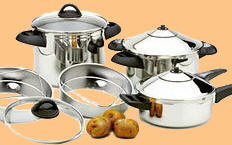|
Â
Go to:-Â Â
Cookware - Pressure Cookers |Â
Buy Pressure
Cookers |Â
Pressure Cooker RecipesÂ
Â
Jump to:-Â Â Â
Why Use a Pressure
Cooker ? |
Safety TipsÂ
|Â
General Cooking Tips
 |
Adapting Recipes
 |Â
General Timings
Â

Â
Â
The shorter
cooking time and reduced liquid means less vitamins and minerals are lost than
through conventional boiling methods. Also as food cooks much faster not
only is pressure cooking a great time saver but less energy is used. Â
Furthermore, your kitchen stays cooler and cleaner because the food is cooked in
a covered, sealed pan which retains all the steam in the pot and there areÂ
splashes or boiled over foods messing up your cooker, work surfaces or
walls.
Back to Top
Â
Â
-
Modern
pressure cookers have at least three safety valves which release pressure
automatically should the pressure get too high. Different pressure
cookers have different valves so it is important for you to refer to the
instructions for your particular model. However in general, if you hear loud
hissing noises coming from the pot, you should check the pressure and
reduce the heat source as necessary.
-
Never
fill your pressure cooker past the manufacturer's mark or more than
two thirds full with solids, half full with liquids and cereals and
one-third full with pulses. This is very important because as the
steam builds up it will need space and over filling can result in food
clogging up the valves preventing pressure from being released.
-
Once
pressure has been reached, lower the temperature so it doesn't build
too high. It should just be releasing a gentle steady stream of steam. If
you don't have a heat source which is immediately adjustable such as gas or
halogen, it is a good idea to have one burner set on low heat whilst you
build the pressure in the cooker on another set to high then once the
desired pressure has been reached you can move the pressure cooker to the
lower heat burner.
Â
|
|
|
-
For
recipes such as stews, you can generally use less liquid than you would with
conventional cooking methods because less liquid will evaporate due to the
fact that the lid is sealed. However, bear in mind that pressure cooking
requires sufficient liquid to create the steam, usually a minimum of
300ml/10fl.oz. In general add another 150ml/5fl.oz. for each extra 15
minutes of cooking.
-
Add
different types of ingredients at different stages in the cooking i.e.
slower cooking ingredients such as meat first, then release the
pressure after an appropriate time and add faster cooking ingredients such
as vegetables. This ensures the end dish has a variety of textures instead
of a mush.
-
Begin
counting the cooking times once the pressure cooker has reached the full
pressure or the PSI stated in the recipe and estimate cooking times on
the low side as a few extra minutes can overcook foods such as vegetables.
It's better to check for doneness by releasing pressure and opening the pot.Â
If it's not cooked, simply replace the lid, return to pressure and cook a
little longer.
-
Releasing Steam
You cannot open modern pressure cookers until the pressure has been
completely released. However, if you have an older pressure cooker, always
be guided by the manufacturer's instructions.
There are two ways to release the pressure, depending on the circumstances.
The Natural (slow) Release Method - Suitable
for stocks, soups containing beans or pasta, cereals, pulses and stews made
with tougher cuts of meat which will benefit from the extra time taken.
Simply remove the pan from the heat source and leave until the pressure has
dropped - usually between 10 and 15 minutes.
Quick Release Method - Suitable for soups,
fish, poultry and vegetables. Some pressure cookers have an automatic
release method so check the instructions. If yours hasn't, transfer the
pressure cooker to the sink and run cold water over the top until the
all the pressure is released. This generally takes less than a minute.
Â
Although almost anything can be cooked in a pressure cooker, it's best suited
for foods that require longer cooking times, such as stews, joints, soups and
pulses.
In general, there aren't that many changes which have to be made when adapting
recipes for the pressure cooker provided there is enough liquid used to create
the steam, usually a minimum of 300ml/10fl.oz although the longer the cooking
time the more liquid is needed. In general add another 150ml/5fl.oz. for each
extra 15 minutes of cooking.
Follow your recipe up to the point where the liquid is added, e.g. brown meats
and vegetables like onions if stated.
Â
Add
vegetables like potatoes later in the cooking stage so they don't overcook and
turn to mush.
Â
When
cooking beans, be sure to soak them in boiling water for at least 1 hour before
adding to the pressure cooker.
Back to Top
Â
Â
Cooking
times vary according to the size or thickness of the food - not the weight. Â So
it is possible to cook 900g/2lb of meat in the same time as
1.8k/4lb of meat provided the pieces are the same size as in the original
recipe.
Â
In general,
you can decrease the length of cooking time for a conventional recipe by two
thirds so, if a beef stew normally takes 2 hours, in a pressure cooker it
will only take 40 minutes.
 |

